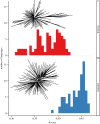The uses and abuses of tree thinking in cultural evolution
- PMID: 33993767
- PMCID: PMC8126464
- DOI: 10.1098/rstb.2020.0056
The uses and abuses of tree thinking in cultural evolution
Abstract
Modern phylogenetic methods are increasingly being used to address questions about macro-level patterns in cultural evolution. These methods can illuminate the unobservable histories of cultural traits and identify the evolutionary drivers of trait change over time, but their application is not without pitfalls. Here, we outline the current scope of research in cultural tree thinking, highlighting a toolkit of best practices to navigate and avoid the pitfalls and 'abuses' associated with their application. We emphasize two principles that support the appropriate application of phylogenetic methodologies in cross-cultural research: researchers should (1) draw on multiple lines of evidence when deciding if and which types of phylogenetic methods and models are suitable for their cross-cultural data, and (2) carefully consider how different cultural traits might have different evolutionary histories across space and time. When used appropriately phylogenetic methods can provide powerful insights into the processes of evolutionary change that have shaped the broad patterns of human history. This article is part of the theme issue 'Foundations of cultural evolution'.
Keywords: cross-cultural research; cultural evolution; cultural macro-evolution; phylogenetic comparative methods.
Figures



Similar articles
-
The potential to infer the historical pattern of cultural macroevolution.Philos Trans R Soc Lond B Biol Sci. 2021 Jul 5;376(1828):20200057. doi: 10.1098/rstb.2020.0057. Epub 2021 May 17. Philos Trans R Soc Lond B Biol Sci. 2021. PMID: 33993769 Free PMC article.
-
The cultural evolution and ecology of institutions.Philos Trans R Soc Lond B Biol Sci. 2021 Jul 5;376(1828):20200047. doi: 10.1098/rstb.2020.0047. Epub 2021 May 17. Philos Trans R Soc Lond B Biol Sci. 2021. PMID: 33993755 Free PMC article.
-
Underappreciated features of cultural evolution.Philos Trans R Soc Lond B Biol Sci. 2021 Jul 5;376(1828):20200259. doi: 10.1098/rstb.2020.0259. Epub 2021 May 17. Philos Trans R Soc Lond B Biol Sci. 2021. PMID: 33993758 Free PMC article. Review.
-
Evolutionary approaches to cultural and linguistic diversity.Philos Trans R Soc Lond B Biol Sci. 2010 Dec 12;365(1559):3781-5. doi: 10.1098/rstb.2010.0202. Philos Trans R Soc Lond B Biol Sci. 2010. PMID: 21041203 Free PMC article.
-
Cultural evolution and prehistoric demography.Philos Trans R Soc Lond B Biol Sci. 2021 Jan 18;376(1816):20190713. doi: 10.1098/rstb.2019.0713. Epub 2020 Nov 30. Philos Trans R Soc Lond B Biol Sci. 2021. PMID: 33250027 Free PMC article. Review.
Cited by
-
Convergent evolution in a large cross-cultural database of musical scales.PLoS One. 2023 Dec 13;18(12):e0284851. doi: 10.1371/journal.pone.0284851. eCollection 2023. PLoS One. 2023. PMID: 38091315 Free PMC article.
-
Phylogenetic insight into the origin of tones.Proc Biol Sci. 2023 Jul 12;290(2002):20230606. doi: 10.1098/rspb.2023.0606. Epub 2023 Jul 5. Proc Biol Sci. 2023. PMID: 37403498 Free PMC article.
-
Geography is not destiny: A quantitative test of Diamond's axis of orientation hypothesis.Evol Hum Sci. 2024 Jan 4;6:e5. doi: 10.1017/ehs.2023.34. eCollection 2024. Evol Hum Sci. 2024. PMID: 38274321 Free PMC article.
-
Foundations of cultural evolution.Philos Trans R Soc Lond B Biol Sci. 2021 Jul 5;376(1828):20200041. doi: 10.1098/rstb.2020.0041. Epub 2021 May 17. Philos Trans R Soc Lond B Biol Sci. 2021. PMID: 33993761 Free PMC article. No abstract available.
-
The potential to infer the historical pattern of cultural macroevolution.Philos Trans R Soc Lond B Biol Sci. 2021 Jul 5;376(1828):20200057. doi: 10.1098/rstb.2020.0057. Epub 2021 May 17. Philos Trans R Soc Lond B Biol Sci. 2021. PMID: 33993769 Free PMC article.
References
-
- Garamszegi LZ. 2014. Modern phylogenetic comparative methods and their application in evolutionary biology: concepts and practice. Berlin, Germany: Springer-Verlag.
-
- Mendoza Straffon L (ed.). 2016. Cultural phylogenetics. Concepts and applications in archaeology. Berlin, Germany: Springer International Publishing.
-
- Greenhill SJ, Gray RD. 2009. Austronesian language phylogenies: myths and misconceptions about Bayesian computational methods. In Austronesian historical linguistics and culture history: a Festschrift for Robert Blust (eds Adelaar A, Pawley A), pp. 375-397. Canberra, Australia: Pacific Linguistics.
Publication types
MeSH terms
LinkOut - more resources
Full Text Sources
Other Literature Sources

